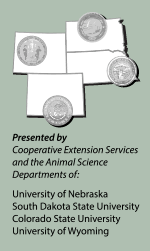Increasing Percent of Cows Bred
in First 30 Days Improves the Bottom Line
Impact of estrus synchronization and artificial insemination on cow herd performance.
LOVELAND, Colo. (Nov. 17) — “Pregnancy has a four times greater economic impact than any other production trait in a cow herd, yet how many producers select for pregnancy first?” That was the question Cliff Lamb posed to attendees at the 24th Range Beef Cow Symposium on Tuesday, Nov. 17. Lamb, who is with the North Florida Research & Education Center, shared findings from research with the Center’s cow herd when an emphasis was placed on selecting for pregnancy.

Cliff Lamb
Lamb and NFREC staff initiated a study in 2008 to keep only the females in the herd that were bred within the first 25 days of the breeding season. Additional criteria for cows to remain in the herd included calving by 24 months of age, calving every 365 days with no assistance, providing enough resources for her calf to reach its genetic potential, maintaining body condition score and not having disposition issues.
As a result of using estrus synchronization, artificial insemination (AI) and the strict culling rule eliminating heifers that did not become pregnant after the first 25 days of the breeding season, through about a six-year period the Center’s herd moved from a 120-day breeding season to a 70-day breeding season. Longevity of the herd’s females increased, and females in the herd tended to wean heavier calves. As well, the herd at NFREC experienced an increase in herd value of $50,000 annually.
Producers often tend to get hung up on pregnancy rates with AI, Lamb said. “To me, the most important thing is what percent of the herd is bred within the first 21 to 30 days, so you can calve more calves in the first 30 days of the calving season.
Lamb also underscored the value of estrus synchronization and AI by sharing data from a study done in South Dakota looking at pregnancy rates of eight different herds. Three operations had pregnancy rates in the 56% to 65% range. Five operations had pregnancy rates in the 44% to 50% range. What was the difference? Lamb reported that the three operations with the higher rates had done AI for several years, whereas the five operations with the lower percentage had not.
“That tells me producers must stick with it (synchronization and AI). It’s not just something to try one time [to test the results] and be done.” He added, “If you get poor pregnancy rates, don’t give up, stick with it over a period of time and it will improve.”
To help producers evaluate costs of AI compared with costs of purchasing bulls, Lamb suggested using the AI Cowculator, which is available as a free app download. Learn more at https://www.facebook.com/AICowculator/.
Editor’s Note: This summary was written under contract or by staff of the Angus Journal®, which retains the copyright. To request to reprint this article, contact Shauna Rose Hermel, editor, at 816-383-5270. PowerPoints are posted with permission of the presenter and may not be reproduced in whole or in part without the express permission of the presenter. Angus Journal claims copyright to this web site as presented. We welcome educational venues and cattlemen to link to this site as a service to their audience.
The Angus Journal's coverage of the event is made possible through collaboration with the event committee and sponsorship of LiveAuctions.tv. For questions about this site, or to notify us of broken links, click here. Look for additional coverage in the Angus Journal, the Angus Beef Bulletin, the Angus Journal Daily, the Angus Beef Bulletin EXTRA and Angus TV.


